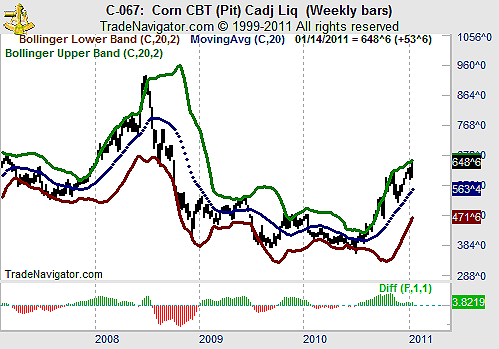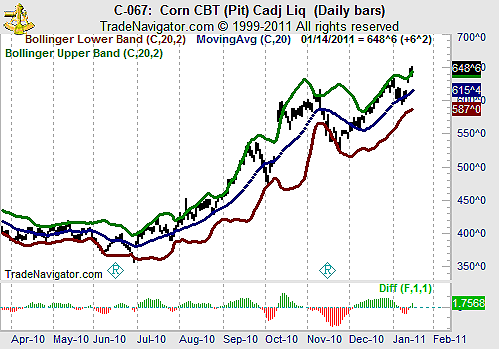
HOT TOPICS LIST
- MACD
- Fibonacci
- RSI
- Gann
- ADXR
- Stochastics
- Volume
- Triangles
- Futures
- Cycles
- Volatility
- ZIGZAG
- MESA
- Retracement
- Aroon
INDICATORS LIST
LIST OF TOPICS
PRINT THIS ARTICLE
by Mike Carr, CMT
The USDA crop report was bullish for corn and other grains, and corn futures rose almost 9.6% in a week.
Position: N/A
Mike Carr, CMT
Mike Carr, CMT, is a member of the Market Technicians Association, and editor of the MTA's newsletter, Technically Speaking. He is also the author of "Smarter Investing in Any Economy: The Definitive Guide to Relative Strength Investing," and "Conquering the Divide: How to Use Economic Indicators to Catch Stock Market Trends."
PRINT THIS ARTICLE
MACD
Corn Jumped, And Could Go Higher
01/20/11 08:34:37 AMby Mike Carr, CMT
The USDA crop report was bullish for corn and other grains, and corn futures rose almost 9.6% in a week.
Position: N/A
| Futures trading involves following a different set of fundamentals than stock market investing does. The US Department of Agriculture estimates how many acres will be planted with various products, how much each acre will produce, and how much of the crop is in storage and available for use. In the January 2011 report, the estimates for the yield (how much will be produced) and supply of corn and other grains were all lowered. The markets moved higher on this news. |
| Corn had already been in a bull market (Figure 1). It was up more than 60% in the six months leading up to last week. Interestingly, the moving average convergence/divergence (MACD) was bullish, but not confirming the higher prices. This is known as a divergence, and many traders would assume it is a bearish signal. More than anything, this highlights the danger of using divergences on a long-term chart to trade. |

|
| FIGURE 1: CORN, WEEKLY. The weekly chart of the corn futures contact shows that corn was very strong in the last half of 2010. |
| Graphic provided by: Trade Navigator. |
| |
| The daily chart (Figure 2) adds confidence that the bullish price surge can continue. The MACD crossed above the zero line on the gap higher that followed the news. Indicators can be applied to futures markets, but a single indicator is unlikely to deliver long-term success. These markets are dominated by professionals, and simple trading tools should be used only as one data point. Trend-following systems have demonstrated positive long-term results, with great risks, in futures markets. |

|
| FIGURE 2: CORN, DAILY. The MACD turned bullish and confirmed the price breakout. |
| Graphic provided by: Trade Navigator. |
| |
| Corn is a very liquid, low-margin futures contract. If nothing else, it serves as a good training contract, allowing traders to learn the differences between trading futures and stocks. And as last week's move shows, it can deliver large rewards to traders on the right side of the market. Futures trading is risky, and stop-loss orders should be considered as a risk management tool. |
Mike Carr, CMT, is a member of the Market Technicians Association, and editor of the MTA's newsletter, Technically Speaking. He is also the author of "Smarter Investing in Any Economy: The Definitive Guide to Relative Strength Investing," and "Conquering the Divide: How to Use Economic Indicators to Catch Stock Market Trends."
| Website: | www.moneynews.com/blogs/MichaelCarr/id-73 |
| E-mail address: | marketstrategist@gmail.com |
Click here for more information about our publications!
Comments
Date: 01/25/11Rank: 4Comment:

|

Request Information From Our Sponsors
- StockCharts.com, Inc.
- Candle Patterns
- Candlestick Charting Explained
- Intermarket Technical Analysis
- John Murphy on Chart Analysis
- John Murphy's Chart Pattern Recognition
- John Murphy's Market Message
- MurphyExplainsMarketAnalysis-Intermarket Analysis
- MurphyExplainsMarketAnalysis-Visual Analysis
- StockCharts.com
- Technical Analysis of the Financial Markets
- The Visual Investor
- VectorVest, Inc.
- Executive Premier Workshop
- One-Day Options Course
- OptionsPro
- Retirement Income Workshop
- Sure-Fire Trading Systems (VectorVest, Inc.)
- Trading as a Business Workshop
- VectorVest 7 EOD
- VectorVest 7 RealTime/IntraDay
- VectorVest AutoTester
- VectorVest Educational Services
- VectorVest OnLine
- VectorVest Options Analyzer
- VectorVest ProGraphics v6.0
- VectorVest ProTrader 7
- VectorVest RealTime Derby Tool
- VectorVest Simulator
- VectorVest Variator
- VectorVest Watchdog
